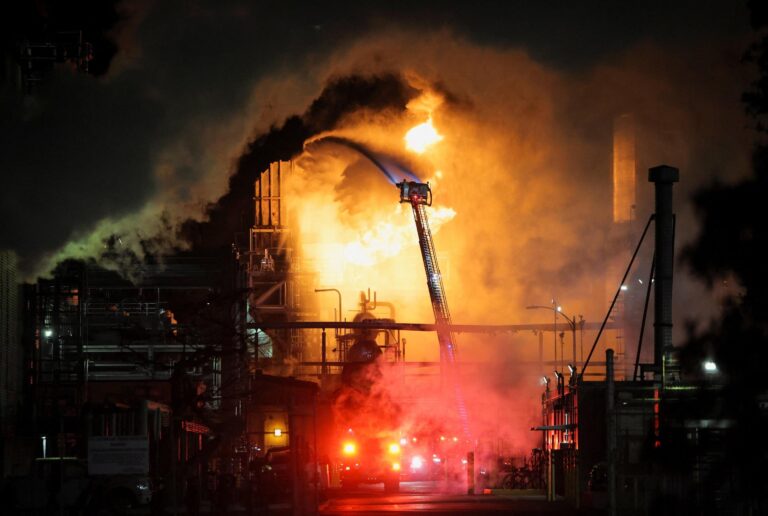Chevron Refinery Fire Near Los Angeles: Community Disruptions and Air Quality Concerns
A notable fire erupted today at the Chevron refinery located on the outskirts of Los Angeles, triggering widespread alarm among local residents and officials. The intense flames forced emergency teams into action, leading to evacuations in nearby neighborhoods and sparking urgent warnings about deteriorating air quality. Authorities have urged residents to remain indoors and limit outdoor exposure as hazardous smoke continues to spread. Efforts to control the fire are ongoing, with investigations launched to identify the root cause of the incident.
The fire has caused a sharp increase in air pollutants, as evidenced by data from monitoring stations in the vicinity. Key environmental and public health impacts observed include:
- Elevated levels of fine particulate matter (PM2.5)
- Surges in volatile organic compounds (VOCs)
- Temporary closure of schools and disruption to public transit services
- Increased vulnerability for individuals with asthma and other respiratory illnesses
| Air Quality Metric | Typical Level | Current Reading |
|---|---|---|
| PM2.5 (µg/m³) | 12 | 75 |
| VOCs (ppb) | 5 | 28 |
Coordinated Emergency Response and Fire Suppression Tactics at Chevron Refinery
Promptly following the detection of the fire, Chevron’s emergency response team activated complete safety protocols aimed at protecting both refinery personnel and the surrounding population. Firefighters, hazardous materials specialists, and safety officers collaborated closely with local emergency services to secure the area, establish evacuation zones, and mitigate risks. Continuous air quality assessments were launched to monitor pollutant levels, providing vital information to public health officials and residents.
Fire containment efforts have focused on isolating the affected section of the refinery to prevent the blaze from spreading further. High-pressure foam systems and water cannons have been deployed to cool adjacent equipment, while technical teams have worked to safely depressurize storage tanks and close valves. A centralized incident command center coordinates communication between Chevron management, emergency responders, and regulatory agencies to ensure a unified and effective response.
- Evacuation of all non-essential personnel within a 2-mile radius
- Ongoing air quality surveillance by EPA and local environmental agencies
- Joint firefighting operations between Chevron and Los Angeles Fire Department
- Activation of refinery-wide emergency shutdown procedures
| Response Measure | Current Status | Effectiveness |
|---|---|---|
| Evacuation Zone | 2 miles | Reduced public exposure |
| Foam Submission | Active | Fire suppression ongoing |
| Air Monitoring | Continuous | Ensures public safety |
| Personnel Accountability | Confirmed | All emergency teams operational |
Environmental and Health Ramifications of the Chevron Refinery Fire
The Chevron refinery fire has unleashed a significant environmental threat, with thick smoke and toxic emissions compromising air quality in adjacent communities. Elevated concentrations of pollutants such as sulfur dioxide (SO2),nitrogen oxides (NOx),and volatile organic compounds (VOCs) have been detected,all of which contribute to smog formation and pose serious respiratory hazards. Moreover, chemical-laden runoff from firefighting efforts risks contaminating nearby water bodies, perhaps harming aquatic ecosystems and jeopardizing drinking water supplies.
Primary environmental and health concerns identified include:
- Increased airborne carcinogens and fine particulate pollution
- Potential soil and groundwater contamination from chemical runoff
- Elevated risk of respiratory complications for sensitive groups
- Disruption to local flora and fauna due to toxic exposure
| Pollutant | Health Implications | Environmental Consequences |
|---|---|---|
| Sulfur Dioxide (SO2) | Triggers asthma attacks, causes respiratory irritation | Leads to acid rain, damages vegetation |
| Volatile Organic Compounds (VOCs) | Irritates eyes, nose, throat; linked to cancer risk | Contributes to smog and toxic water contamination |
| Particulate Matter (PM2.5) | Increases risk of heart and lung diseases, mortality | Reduces visibility, contaminates soil |
Recommended Safety Protocols for Residents and Emergency Responders
Residents living near the affected area are strongly advised to stay indoors, seal windows and doors tightly, and turn off air conditioning or ventilation systems to minimize smoke inhalation. It is prudent to have protective face masks available, especially for children, seniors, and individuals with pre-existing respiratory conditions. Authorities also recommend limiting vehicle use in the vicinity to facilitate emergency operations. Continuous updates will be provided through local news outlets and official social media channels.
For emergency workers and refinery staff, strict compliance with safety measures is essential. Use of personal protective equipment (PPE),including flame-resistant gear,helmets,and self-contained breathing apparatuses,is mandatory. Coordination between firefighting units and refinery safety teams remains critical to monitor hazardous zones and execute controlled evacuations if conditions worsen. The table below outlines key safety actions advised during refinery fire emergencies:
| Safety Measure | Target Group | Priority Level |
|---|---|---|
| Evacuate non-essential personnel | Residents & Workers | High |
| Wear self-contained breathing apparatus | Firefighters | Critical |
| Seal indoor air intakes | Residents | Medium |
| Establish secure perimeter zones | Emergency Coordinators | High |
Conclusion and Ongoing Updates on the Chevron Refinery Fire
As firefighting teams persist in their efforts to extinguish the significant blaze at the Chevron refinery near Los Angeles, investigations into the fire’s origin are actively progressing. Authorities continue to monitor air quality closely and prioritize the safety of nearby residents. This situation remains fluid, and further updates will be provided as new information emerges.




